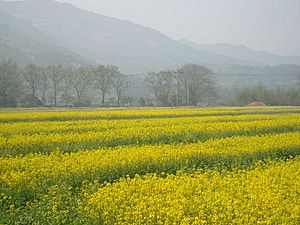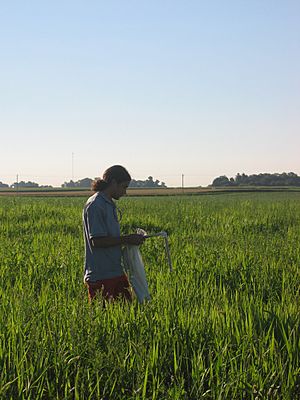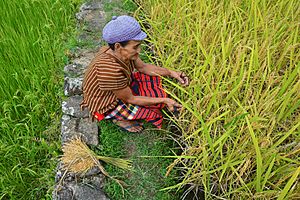Agronomy facts for kids
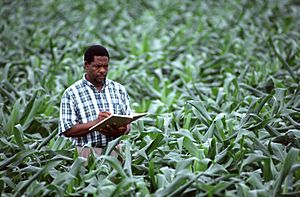
An agronomist measures and records corn growth and other processes.
|
|
| Occupation | |
|---|---|
| Names | agronomist agricultural scientist crop scientist |
|
Occupation type
|
profession |
|
Activity sectors
|
agriculture, agronomy |
| Description | |
| Competencies | technical knowledge, sense of analysis |
|
Fields of
employment |
food industry, science, research and development |
|
Related jobs
|
see related disciplines |
Agronomy is a special science that helps us grow plants better. It's all about using science and technology to produce plants for things like food, fuel, and even to fix damaged land. Agronomy is both a scientific job and one that helps people.
Agronomists use many different sciences. These include biology (the study of living things), chemistry (the study of matter), ecology (the study of how living things interact with their environment), and genetics (the study of how traits are passed down).
Today, agronomists work on many important issues. They help produce enough food for everyone. They also work to create healthier food and manage how farming affects our environment. Agronomists also look at how to get energy from plants.
These scientists often focus on specific areas. This can include how to rotate crops, how to water plants (irrigation), and how to improve plants through plant breeding. They also study soil to make it healthy and control weeds and pests.
Contents
Making Better Plants: Plant Breeding
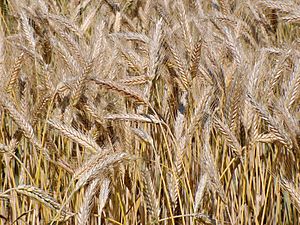
One big part of agronomy is called plant breeding. This is like choosing the best qualities in plants. Agronomists carefully select plants to create new, stronger types. These new plants can grow well in different conditions.
Plant breeding has helped farms grow much more food. It has also made crops like corn, soybeans, and wheat more nutritious.
This science has even led to completely new plants! For example, a special grain called triticale was created. It's a hybrid of rye and wheat. Triticale has more useful protein than either rye or wheat alone. Agronomy is also key in making our fruits and vegetables better.
Using Science to Improve Plants: Biotechnology
Agronomists use biotechnology to speed up the process of developing plants with desired traits. Biotechnology often starts in a lab. Then, the new plant types are tested in real fields.
Besides helping crops grow more, agronomic biotechnology is used for new things beyond food. For example, oilseed plants are mostly used for cooking oils. But they can be changed to produce special fats for detergents or even fuels.
Understanding the Ground: Soil Science
Agronomists study how to make soil more productive and healthy in a sustainable way. They learn about different types of soil. They also test soil to see if it has the right nutrients for plants to grow.
They check things like how much organic material is in the soil. They also look at the soil's pH (how acidic or basic it is). Agronomists then use these test results to suggest what the soil needs. This helps plants grow as well as possible.
Protecting Our Soil: Soil Conservation
Agronomists also create ways to protect the soil. They work to stop erosion, which is when wind and water carry away valuable soil. For instance, a technique called contour plowing helps prevent soil erosion and saves rainwater.
Researchers in agronomy also look for better ways to use soil to solve other problems. This includes dealing with animal waste and preventing water pollution. They also work on stopping too many pesticides from building up in the soil. Some methods include not tilling crops and planting special grasses on slopes.
Farming with Nature: Agroecology
Agroecology is about managing farms in a way that respects nature and the environment. This area of study is closely linked to sustainable agriculture. It also connects with organic farming and finding new ways to grow food.
How Plants Grow: Theoretical Modeling
Theoretical production ecology is a field that studies how crops grow. It looks at a plant like a small factory. This "factory" uses light, carbon dioxide, water, and nutrients to create the parts we can harvest.
See also
 In Spanish: Agronomía para niños Eva Ekeblad
In Spanish: Agronomía para niños Eva Ekeblad
Images for kids
-
An agronomist mapping a plant genome.


